The magic of the Neptune Fountain: a piece of childhood in Berlin Mitte
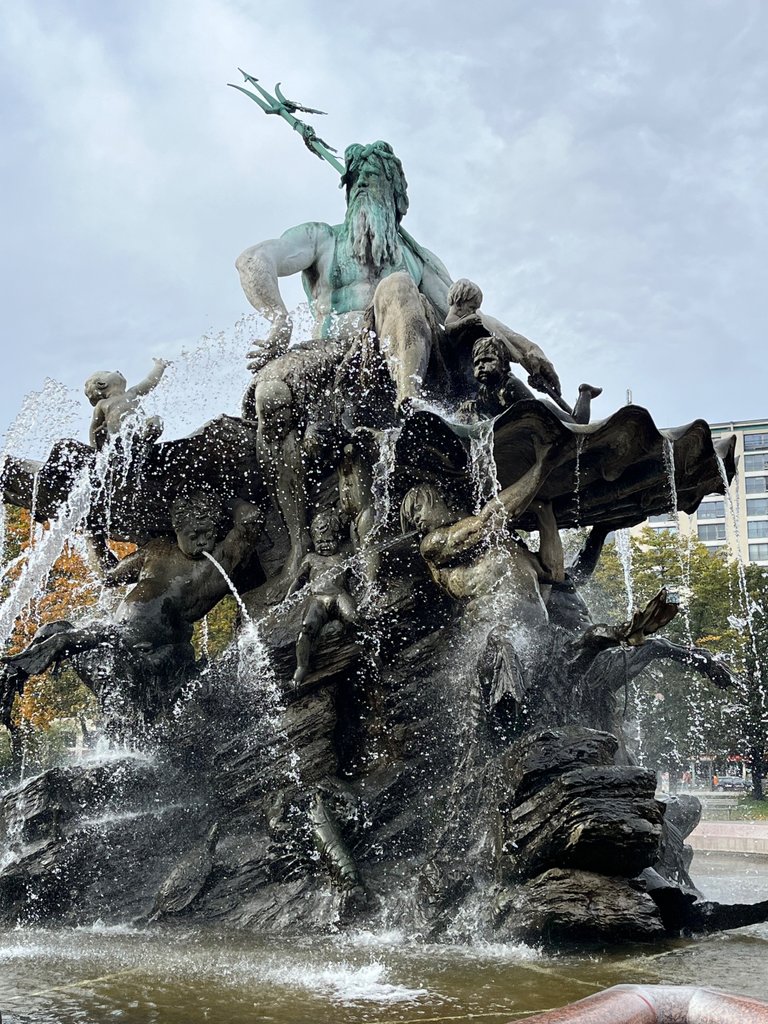
Berlin is a city full of memories and stories, and the Neptune Fountain in Berlin Mitte is a living legend that has been with me since my childhood. The lines in this article may be tinged with personal affection, but the Neptune Fountain itself exudes a magic that is hard to escape.
A childhood memory
Even as a child, I loved visiting the Neptune Fountain. It was not only an impressive work of art for me, but also a place where I spent wonderful times with my family. My parents often brought me here and I remember climbing onto the laps of the imposing female figures at the edge of the pool. These memories are a close connection between me and this fountain that continues to this day.

History and significance
The Neptune Fountain was built between 1888 and 1891 in the Neo-Baroque style by Reinhold Begas. It was originally a gift from the city of Berlin to Kaiser Wilhelm II and was located on Schloßplatz. After the demolition of the Berlin Palace in 1951, the fountain was removed. But its journey was not over yet.
During the redesign of East Berlin's city center in 1969, the Neptune Fountain found its new home on Alexanderplatz in the immediate vicinity of the television tower, between the Rotes Rathaus and St. Mary's Church. With a height of 10 meters and a diameter of 18 meters made of granite and bronze, the fountain cannot be overlooked.
The splendor in detail
The Neptune Fountain is not only impressive because of its size, but also because of the attention to detail. An imposing rock pedestal sits enthroned in the center of the fountain bowl, surrounded by a variety of sea creatures, including lobsters, crabs, fish and polyps. Water-spouting sea and river animals such as sea turtles, seals, crocodiles and snakes add something dramatic and very imposing to the whole spectacle.
The centerpiece of the fountain is formed by four tritons, which carry a large mussel shell in the manner of centaurs. Neptune, the mighty sea god of Roman mythology, is enthroned in this shell. With his trident commanding the waves lying casually over his left shoulder and his right arm resting on his thigh, he radiates authority and grace.
On the edge of the fountain basin are four larger-than-life female figures, which are great for children to climb on. These symbolic figures represent the four great rivers of Prussia: the Rhine (recognizable by a fishing net and grapes), the Weichsel (with wood, as a symbol of the forests), the Oder (with a goat and fur) and the Elbe (with ears of corn and fruit).
| Rhein | Weichsel | Oder | Elbe |
|---|---|---|---|
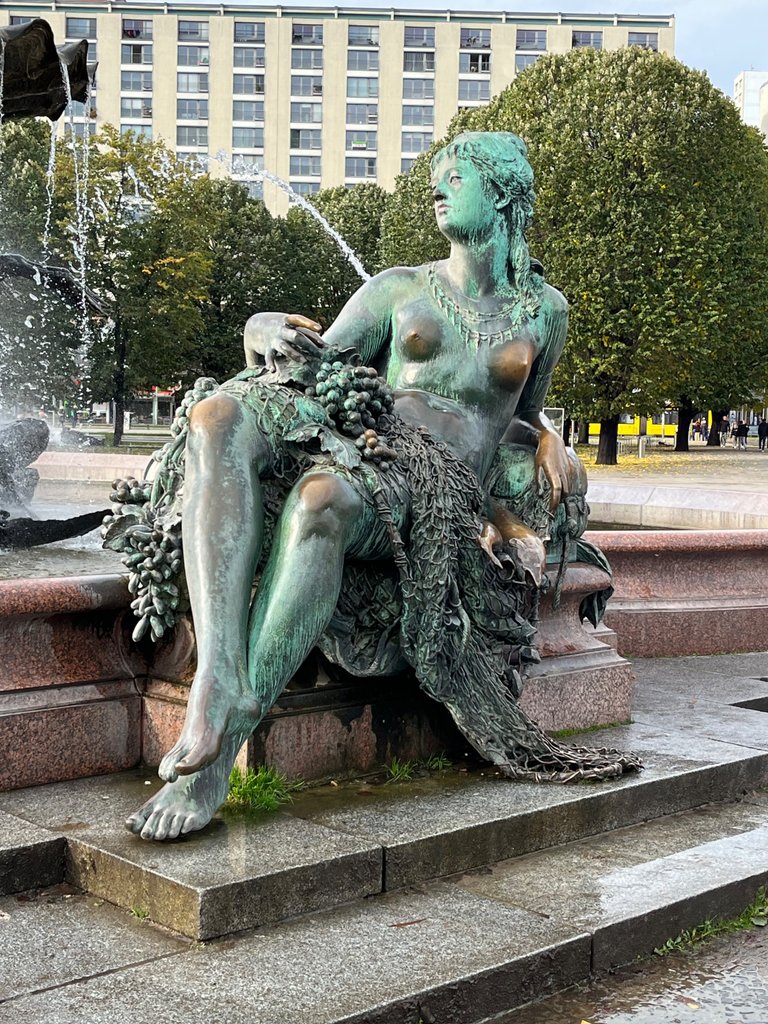 | 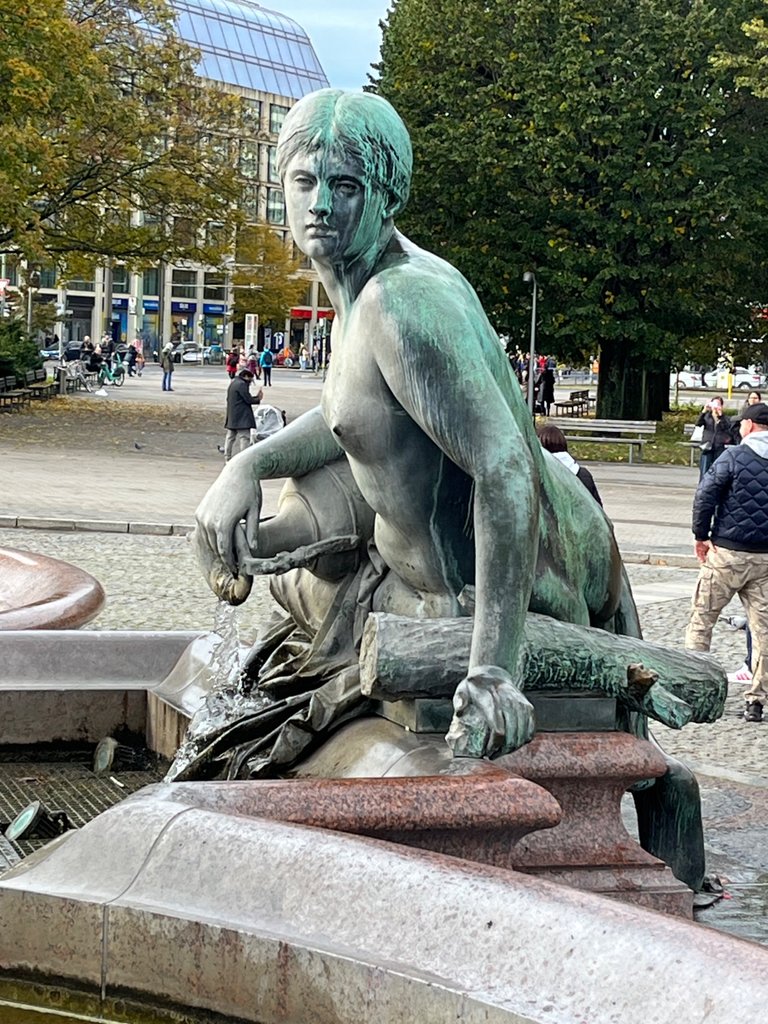 | 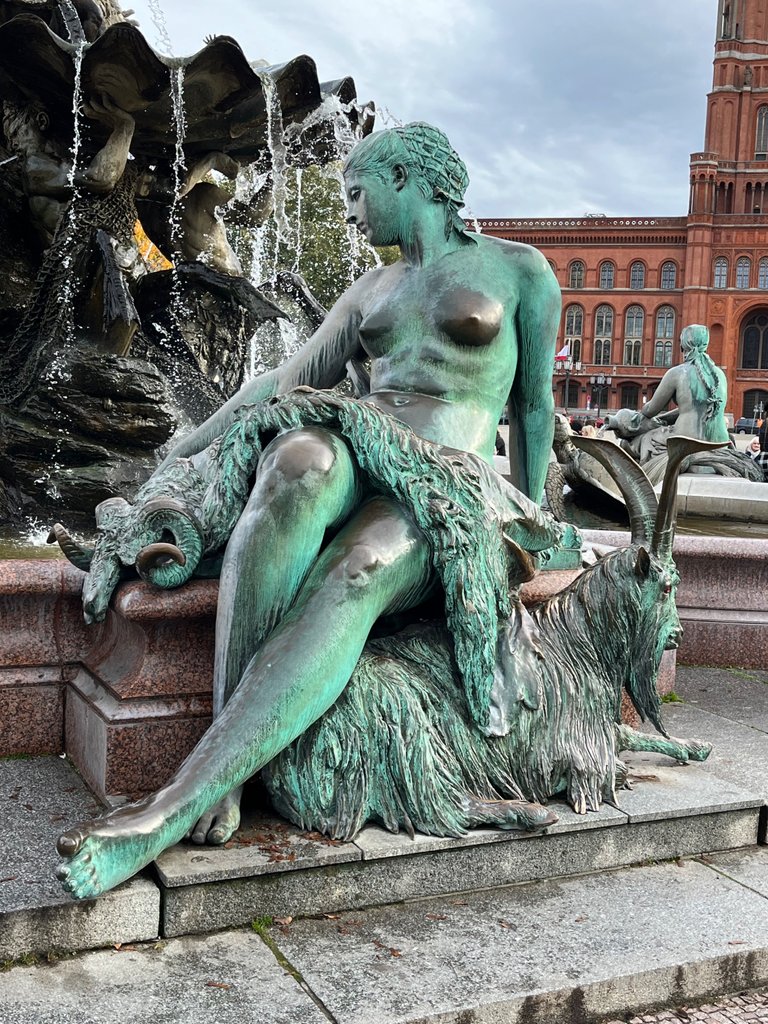 | 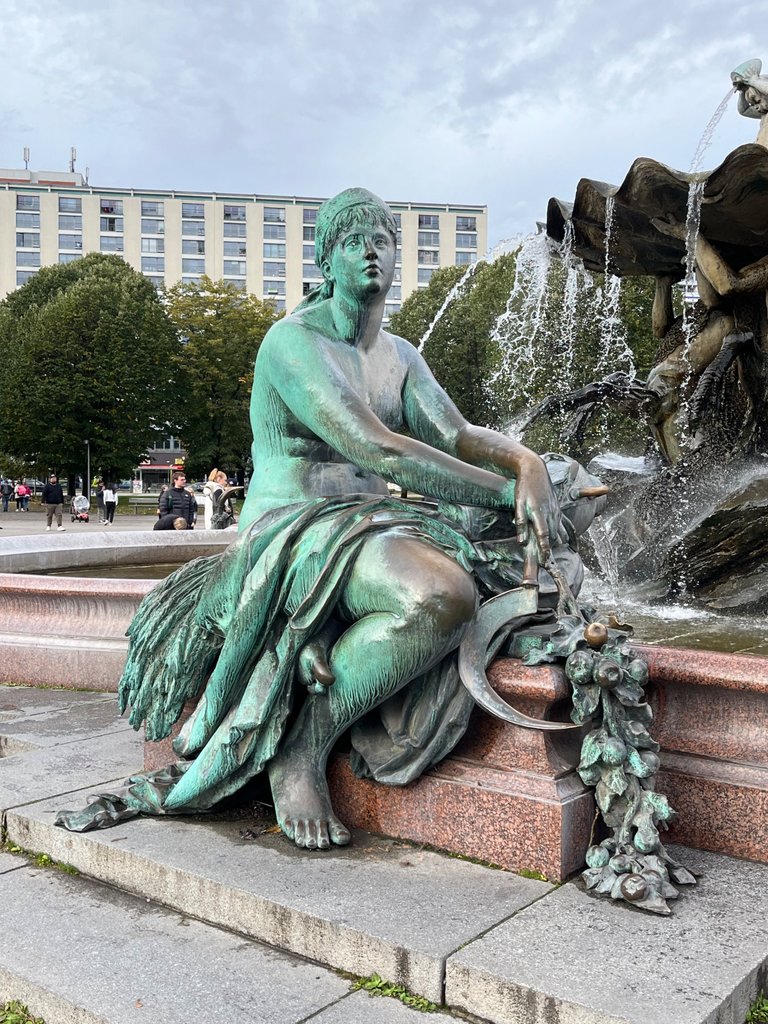 |
A look into the future
With the reconstruction of the Berlin Palace as the Humboldt Forum, there has been discussion about moving the Neptune Fountain to its original location on the Palace Square. For many of us who love this fountain, this idea was not really attractive. But it seems that the Berlin Senate has decided to leave the fountain where it is today.
Instead, they are planning to build a new fountain on the historic site of the Neptune Fountain on Schlossplatz. This decision is very welcome, because for many Berliners the Neptune Fountain belongs on the Alex just as much as the television tower.
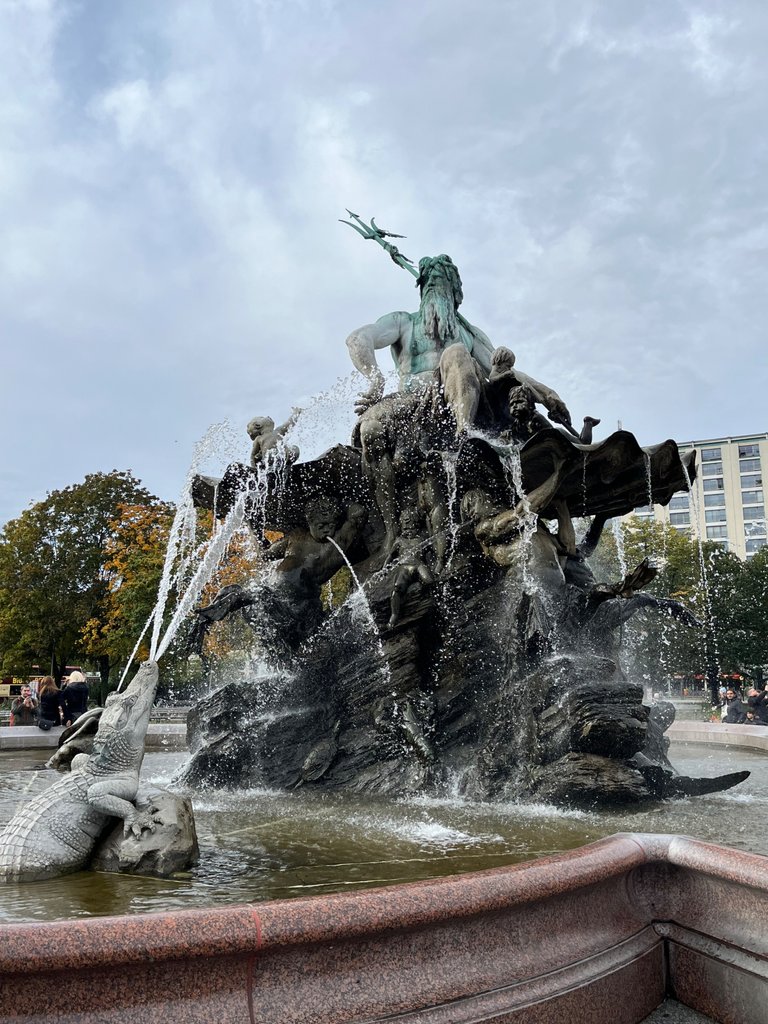
The Neptune Fountain in Mitte will always be a place for me with some wonderful childhood memories attached to it. Even today, I see families gathering here, children climbing around on the fountain and visitors to Berlin marveling. May the magic of this fountain continue to delight and inspire many generations to come.
Ciao Kakao,
Your Morticia
German Version

Die Magie des Neptunbrunnens: Ein Stück Kindheit in Berlin Mitte
Berlin ist eine Stadt voller Erinnerungen und Geschichten, und der Neptunbrunnen in Berlin Mitte ist eine lebendige Legende, die mich seit meiner Kindheit begleitet. Die Zeilen dieses Artikels mögen von persönlicher Zuneigung geprägt sein, aber der Neptunbrunnen selbst strahlt eine Magie aus, der schwer zu entgehen ist.
Eine Kindheitserinnerung
Schon als Kind liebte ich es, den Neptunbrunnen zu besuchen. Er war für mich nicht nur ein beeindruckendes Kunstwerk, sondern auch ein Ort, an dem ich wunderbare Stunden mit meiner Familie verbrachte. Meine Eltern brachten mich oft hierher, und ich erinnere mich daran, wie ich auf den Schoß der imposanten Frauenfiguren am Beckenrand geklettert bin. Dieses Erinnerungen sind eine enge Verbindung zwischen mir und diesem Brunnen, die bis heute anhält.

Geschichte und Bedeutung
Der Neptunbrunnen wurde in den Jahren 1888 bis 1891 im Stil des Neobarocks von Reinhold Begas erbaut. Ursprünglich war er ein Geschenk der Stadt Berlin an Kaiser Wilhelm II. und befand sich auf dem Schloßplatz. Nach dem Abriss des Berliner Schlosses im Jahr 1951 wurde der Brunnen entfernt. Doch seine Reise war noch nicht zu Ende.
Im Zuge der Neugestaltung des Ost-Berliner Zentrums im Jahr 1969 fand der Neptunbrunnen sein neues Zuhause auf dem Alexanderplatz in direkter Nähe zum Fernsehturm, zwischen dem Roten Rathaus und der Marienkirche. Mit einer Höhe von 10 Metern und einem Durchmesser von 18 Metern aus Granit und Bronze ist der Brunnen nicht zu übersehen.
Die Pracht im Detail
Der Neptunbrunnen ist nicht nur beeindruckend aufgrund seiner Größe, sondern auch wegen der Liebe zum Detail. In der Mitte der Brunnenschale thront ein imposanter Felssockel, umgeben von einer Vielzahl von Meerestieren, darunter Hummer, Krebse, Fische und Polypen. Wasserspeiende Meeres- und Flusstiere wie Seeschildkröten, Seehunde, Krokodile und Schlangen fügen dem Ganzen Spektakel etwas dramatisches und sehr imposantes hinzu.
Das Herzstück des Brunnens wird von vier Tritonen gebildet, die in Art der Zentauren eine große Muschelschale tragen. In dieser Muschelschale thront Neptun, der mächtige Meergott der römischen Mythologie. Mit seinem über die Wogen gebietenden Dreizack lässig über der linken Schulter liegend und dem rechten Arm auf den Schenkel gestemmt, strahlt er Autorität und Anmut aus.
Auf dem Rand des Brunnenbeckens befinden sich vier überlebensgroße Frauengestalten, auf denen man als Kind herrlich herumklettern kann. Diese Symbolfiguren repräsentieren die vier großen Flüsse Preußens: der Rhein (erkennbar an einem Fischnetz und Weintrauben), die Weichsel (mit Holz, als Symbol für die Wälder), die Oder (mit einer Ziege und Fell) und die Elbe (mit Ähren und Früchten).
| Rhein | Weichsel | Oder | Elbe |
|---|---|---|---|
 |  |  |  |
Ein Blick in die Zukunft
Mit dem Wiederaufbau des Berliner Schlosses als Humboldt Forum wurde darüber diskutiert, den Neptunbrunnen an seinen ursprünglichen Standort auf dem Schloßplatz zu versetzen. Für viele von uns, die diesen Brunnen lieben, war diese Vorstellung nicht wirklich attraktiv. Doch es scheint, als ob der Berliner Senat entschieden hat, den Brunnen dort zu belassen, wo er sich heute befindet.
Stattdessen plant man, am historischen Standort des Neptunbrunnens auf dem Schloßplatz eine neue Brunnenanlage zu errichten. Diese Entscheidung ist sehr zu begrüßen, denn der Neptunbrunnen gehört für viele Berliner genau so auf den Alex wie der Fernsehturm.

Der Neptunbrunnen in Mitte wird immer ein Ort für mich sein, an dem einige wundervolle Kindheitserinnerungen hängen. Auch heute sehe ich Familien hier zusammenkommen, Kinder auf dem Brunnen herum klettern und die Berlin-Besucher staunen. Möge die Magie dieses Brunnens noch viele Generationen begeistern und inspirieren.
Ciao Kakao,
Your Morticia
Reference
Wikipedia-Artikel
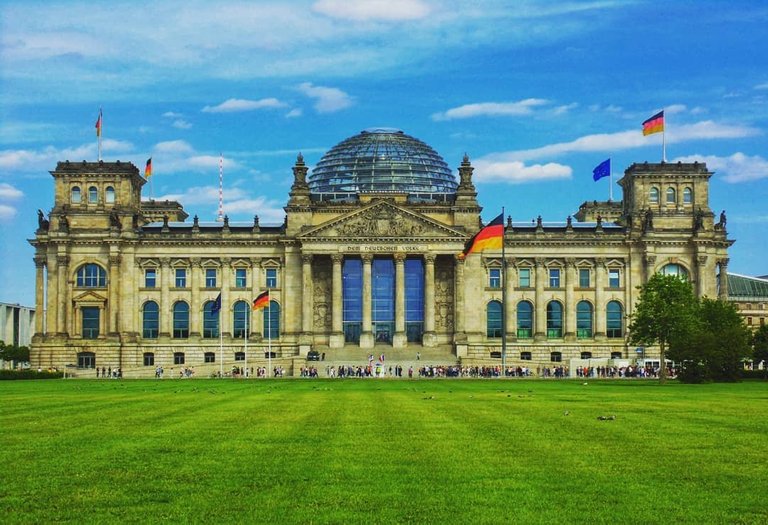 |  | 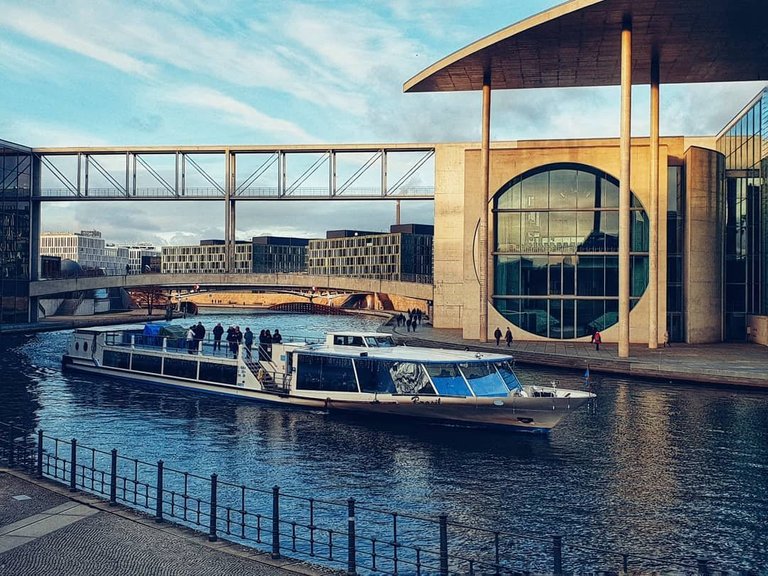 |
| Don't forget to reshare! | For every reshare/rehive you will get one of my Proof-of-Reshare NFTs. Current Edition: Morticia #4 only 30 pices | Don't forget to reshare! |
Congratulations, your post has been added to Pinmapple! 🎉🥳🍍
Did you know you have your own profile map?
And every post has their own map too!
Want to have your post on the map too?
Hiya, @choogirl here, just swinging by to let you know that this post made it into our Honorable Mentions in Travel Digest #2048.
Your post has been manually curated by the @pinmapple team. If you like what we're doing, please drop by to check out all the rest of today's great posts and consider supporting other authors like yourself and us so we can keep the project going!
Become part of our travel community:
In Berlin it's allowed to climb a fountain? !HUG
I sent 1.0 HUG on behalf of @svanbo.
(3/3)
only on the figures on the edge in the middle was it always too wet for me ;-)
I meant that climbing on monuments or fountains isn't allowed in many countries. Don't try such things at the Trevi fountain in Rome for example!!! !HUG
I sent 1.0 HUG on behalf of @svanbo.
(1/3)
I understand... No, people in Berlin are a bit more forgiving and the bronze is perhaps a bit more robust than the marble of the Trevi Fountain
The Italians are a little particular indeed, but on the other hand if everyone just would do what he wants with historical statues.... !HUG
I sent 1.0 HUG on behalf of @svanbo.
(1/3)
Very interesting to read about the female figures and what they stnad for. The crocodile(s) is just for adding "drama"? I mean it doesn't seem to belong there since crocodiles don't live in Germany...?... !BEER
Neptune naturally rules over all life found in the water - including that outside Prussia. The fountain is from 1888 and perhaps the intention was to underpin the claim to German Southwest Africa - or the artist simply wanted to design a crocodile ... who knows - but it is an interesting question. Thank you for your interest in my article :-) #freecompliments
You're welcome! It's very interesting indeed. I also didn't know that Germany has claimed a part of South Africa? Or did I understand that part wrong? !PIZZA
View or trade
BEER.Hey @city-of-berlin, here is a little bit of
BEERfrom @svanbo for you. Enjoy it!Did you know that <a href='https://dcity.io/cityyou can use BEER at dCity game to buy cards to rule the world.
$PIZZA slices delivered:
@svanbo(1/5) tipped @city-of-berlin